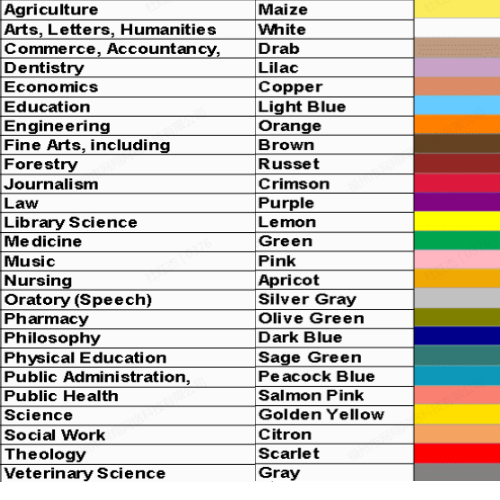A graduation hood, also known as academic hood, is an iconic symbol rich with meaning. It indicates the field of study, specific degree, and much more. In this guide, we’ll have a look at the significance behind graduation hoods, explain their colors and meanings, and provide step-by-step instructions on how to wear your hood with dignity.
What is a Graduation Hood?
The graduation hood is an important part of academic regalia worn during graduation ceremonies. It symbolizes the achievement of earning a higher degree, such as a master’s or doctoral degree. The hood’s design varies depending on the institution, degree level, and academic discipline.
Traditionally, the hood consists of a long, flowing piece of fabric that drapes over the shoulders and down the back. It is typically made of velvet, satin, or a similar high-quality material.
The hood’s lining is visible from the inside and features the colors that represent the specific field of study. These colors, known as “faculty colors,” are standardized across universities. For example, a hood lined with golden yellow indicates a degree in science, while white represents arts and letters.
Degree Graduation Hood Colors & Meaning
There are around 25 different graduation hood colors. Each color is related to a different field of study and degree. Here’s the meaning behind every color:
- Maize: This color represents the field of agriculture, symbolizing the study of cultivating crops, managing lands, and advancing agricultural sciences.
- White: Representing the pure and timeless pursuit of knowledge, white signifies the arts, letters, and humanities.
- Drab: Drab reflects the field of commerce and accountancy.
- Lilac: With its soft and delicate hue, lilac represents the field of dentistry.
- Copper: This earthy color symbolizes the field of economics that shape the financial landscape of societies.
- Light Blue: Evoking clarity and wisdom, light blue signifies the field of education or pedagogy.
- Orange: Orange represents the field of engineering. It celebrates innovative thinkers and problem-solvers.
- Brown: With its rich, natural hue, brown symbolizes the fine arts.
- Russet: This reddish-brown shade represents the field of forestry, honoring those who study and manage complex ecosystems.
- Crimson: The eye-catching crimson represents the field of journalism to celebrate the tireless pursuit of truth.
- Purple: This regal hue of purple represents the field of law.
- Lemon: This bright, cheerful color represents the field of library science.
- Green: Representing the vibrant forces of life and healing, green symbolizes the field of medicine.
- Pink: With its soft hue, pink symbolizes the field of music. It celebrates the universal language of melodies and rhythms.
- Apricot: This shade represents the field of nursing, honoring the care providers who offer support for everyone’s well-being.
- Silver Gray: This color signifies the field of oratory or speech. It celebrates the art of effective communication, public speaking, and the ability to inspire audiences.
- Olive Green: Olive green indicates the field of pharmacy. It represents the dedicated professionals who ensure the safe and effective use of medications.
- Dark Blue: This deep color represents the field of philosophy. It symbolizes the pursuit of wisdom and the exploration of fundamental questions about existence.
- Sage Green: Sage green signifies the field of physical education. It honors those who promote physical fitness.
- Peacock Blue: The majestic peacock blue denotes the field of public administration.
- Salmon Pink: This warm color represents the field of public health. It symbolizes the dedicated efforts to promote well-being and prevent disease.
- Golden Yellow: Golden yellow indicates the field of science. This color celebrates the tireless pursuit of knowledge and the groundbreaking discoveries that shape our understanding of the universe.
- Citron: This vibrant shade represents the field of social work.
- Scarlet: Bold and passionate, scarlet signifies the field of theology or divinity.
- Gray: Gray symbolizes the field of veterinary science. It honors the dedicated professionals who care for the well-being of animals.

These rich and symbolic colors decorate the graduation hoods of scholars, celebrating their achievements and the various fields they have studied.
How to Wear Graduation Hood
Graduation day is a special occasion, and wearing your academic regalia correctly is important to look your best and show respect for the tradition. Here’s a step-by-step guide on how to wear a graduation hood properly:
Step 1: Understand the Hood’s Parts
Before you start, familiarize yourself with the parts of the graduation hood:
- Cape: The fabric that drapes over your back.
- Velvet Trim: The colored band around the opening of the hood, representing your field of study.
- Lining: The colorful interior that typically represents your field of study and degree.
- Button Loop: A small loop inside the hood used for securing it to your gown.
Step 2: Preparation
- Iron Your Hood: Ensure your hood is wrinkle-free. Use a low heat setting or steam to smooth out any creases. Avoid direct contact with the velvet trim.
- Gown: Put on your graduation gown first, making sure it’s zipped up completely.
Step 3: Putting on the Hood
- Drape the Hood:
- Hold the hood by the velvet trim and place it over your head. The velvet side should be facing outward, with the trim around your neck and shoulders.
- Let the cape part drape down your back naturally.
- Securing the Hood:
- Find the button loop inside the hood. It’s usually located near the front opening.
- Attach this loop to the button or hook on your gown, if available. This helps keep the hood in place.
- Adjusting the Cape:
- Smooth out the fabric so it lies flat against your back.
- Ensure the lining shows correctly. The interior should be partially turned out to display the colors prominently.
Step 4: Adjusting for Comfort
- Check the Length: The hood should hang evenly and not be bunched up at the back. Adjust the fabric so it drapes gracefully.
- Velvet Trim: Make sure the trim lies flat around your shoulders and doesn’t twist or fold.
- Cape and Lining: The cape should cover your back, and the lining should be visible but not overly exposed. A little bit of color showing at the bottom of the hood is ideal.
Step 5: Final Checks
- Mirror Check: Look in a mirror to ensure everything is aligned and the hood is sitting correctly.
- Assistance: If possible, ask a friend or family member to check the back of your hood and make any necessary adjustments.
- Comfort: Move around to ensure the hood stays in place and doesn’t restrict your movement.
By following these steps, you’ll wear your graduation hood with confidence. Enjoy your graduation and celebrate your achievements in style!
Final Words
A graduation hood is a symbol of academic achievement, with its colors representing the diverse fields of study. Each hue pays tribute to the invaluable contributions made by individuals to expand human knowledge. As you celebrate this milestone, remember that the day is incomplete without a thoughtful gift. You can check out Callie’s store to find the perfect graduation gift that’ll honor the hard work and dedication of your loved ones.



